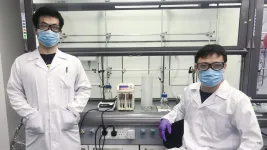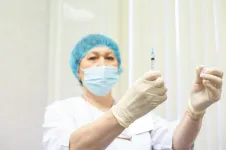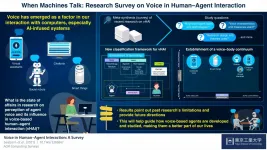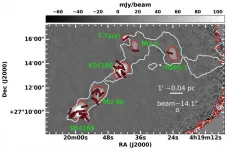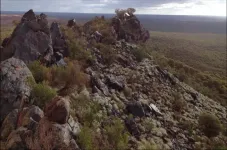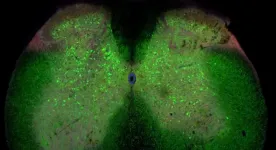(Press-News.org) PHILADELPHIA--An odor-based test that sniffs out vapors emanating from blood samples was able to distinguish between benign and pancreatic and ovarian cancer cells with up to 95 percent accuracy, according to a new study from researchers at the University of Pennsylvania and Penn's Perelman School of Medicine.
The findings suggest that the Penn-developed tool -- which uses artificial intelligence and machine learning to decipher the mixture of volatile organic compounds (VOCs) emitting off cells in blood plasma samples -- could serve as a non-invasive approach to screen for harder-to-detect cancers, such as pancreatic and ovarian.
The results will be presented at the annual American Society of Clinical Oncology meeting on June 4 by A. T. Charlie Johnson, PhD, the Rebecca W. Bushnell Professor of Physics and Astronomy in Penn's School of Arts & Sciences (Abstract # 5544).
"It's an early study but the results are very promising," Johnson said. "The data shows we can identify these tumors at both advanced and the earliest stages, which is exciting. If developed appropriately for the clinical setting, this could potentially be a test that's done on a standard blood draw that may be part of your annual physical."
Co-authors include Erica L. Carpenter, PhD, director of the Circulating Tumor Material Laboratory and research assistant professor in the Perelman School of Medicine, Janos Tanyi, MD, PhD, an assistant professor of Obstetrics and Gynecology, and Cynthia Otto, DVM, PhD, director of the Working Dog Center and professor at Penn's School of Veterinary Medicine (Penn Vet). The late George Preti, PhD, of the Monell Chemical Senses Center, is also co-author.
The Penn research team is currently working with VOC Health to commercialize the device, along with others, for research and clinical applications.
The electronic olfaction -- "e-nose" -- system is equipped with nanosensors calibrated to detect the composition of VOCs, which all cells emanate. Previous studies from the researchers demonstrated that VOCs released from tissue and plasma from ovarian cancer patients are distinct from those released from samples of patients with benign tumors.
Among 93 patients, including 20 patients with ovarian cancer, 20 with benign ovarian tumors and 20 age-matched controls with no cancer, as well as 13 patients with pancreatic cancer, 10 patients with benign pancreatic disease, and 10 controls, the vapor sensors discriminated the VOCs from ovarian cancer with 95 percent accuracy and pancreatic cancer with 90 percent accuracy. The tool also correctly identified all patients (a total of eight) with early-stage cancers.
The technology's pattern recognition approach is similar to the way people's own sense of smell works, where a distinct mixture of compounds tells the brain what it's smelling. The tool was trained and tested to identify the VOC patterns more associated with cancer cells and those associated with cells from healthy blood samples in 20 minutes or less.
The team's collaboration with Richard Postrel, CEO and chief innovation officer of VOC Health, has also led to an improvement in detection speed by 20 fold.
"Collaborating with researchers from the department of Physics and Astronomy, the Perelman School of Medicine, and Penn Vet has allowed us to perfect and integrate our own innovations - expediting the commercialization process," Postrel said. "Initial prototypes of commercial devices able to detect cancer from liquids and vapors will be ready soon and be provided to these Penn researchers to further their work."
In a related effort with VOC Health, Johnson, along with his co-investigator Benjamin Abella, MD, MPhil, a professor of Emergency Medicine, were awarded a two-year, $2 million grant by the National Institutes of Health National Center for Advancing Translational Sciences for the development of a handheld device that can detect the signature "odor" of people with COVID-19, which is based off the cancer-detection technology applied in this study.
INFORMATION:
Penn co-authors also include Christopher Kehayias, a postdoctoral researcher in Johnson's lab, Jody Piltz-Seymour, MD, a clinical professor in the department of Ophthalmology, Mark O'Hara, MD, an assistant professor of Hematology-Oncology, Taylor A. Black, of the Abramson Cancer Center, and Stephanie S. Yee, lab manager of the CTM Laboratory. Young Eun Lee, PhD, of the Monell Chemical Senses Center, is also a co-author.
Johnson will present the findings during a poster presentation on June 4 at 9 am EST. The research was funded by the Kleberg Foundation.
Editor's note: Johnson, Otto, and Abella are co-founders of and equity holders in VOC Health.
Our lives today are governed by electronics in all shapes and forms. Electronics, in turn, are governed by their batteries. However, the traditional lithium-ion batteries (LIBs), that are widely used in electronic devices, are falling out of favor because researchers are beginning to view lithium metal batteries (LMBs) as a superior alternative due to their remarkably high energy density that exceeds LIBs by an order of magnitude! The key difference lies in the choice of anode material: LIBs use graphite, whereas LMBs use lithium metal.
Such a choice, however, comes with its own challenges. Among the most prominent ones is the formation ...
Singapore, 1 June 2021 - The discovery and development of new small-molecule compounds for therapeutic use involves a huge investment of time, effort and resources. Giving a new spin to conventional chemical synthesis, a team of researchers from the National University of Singapore (NUS) has developed a way to automate the production of small molecules suitable for pharmaceutical use. The method can potentially be used for molecules that are typically produced via manual processes, thereby reducing the manpower required.
The research team that achieved this technological breakthrough was led by Assistant Professor Wu Jie from the NUS Department of Chemistry as well as Associate Professor Saif A. Khan from ...
Bribery in the public healthcare does not solve the problem of poor quality of services, and even exacerbates it, researchers argue. The same can be said about the well-being of patients and their own assessment of health. In other words, bribes in the healthcare do not provide good quality services and do not pay off. Such conclusions were reached by an international team of researchers, including Olga Popova, the article's co-author, an associate professor at the Ural Federal University (UrFU, Russia).
Researchers examined survey data on 41,000 citizens from 28 post-communist countries in Central and Eastern Europe, as well as ...
Tokyo - Machine learning is the process by which computers adapt their responses without human intervention. This form of artificial intelligence (AI) is now common in everyday tools such as virtual assistants and is being developed for use in areas from medicine to agriculture. A challenge posed by the rapid expansion of machine learning is the high energy demand of the complex computing processes. Researchers from The University of Tokyo have reported the first integration of a mobility-enhanced field-effect transistor (FET) and a ferroelectric capacitor (FE-CAP) to bring the memory system into the proximity of a microprocessor and improve the ...
In the modern day, our interactions with voice-based devices and services continue to increase. In this light, researchers at Tokyo Institute of Technology and RIKEN, Japan, have performed a meta-synthesis to understand how we perceive and interact with the voice (and the body) of various machines. Their findings have generated insights into human preferences, and can be used by engineers and designers to develop future vocal technologies.
As humans, we primarily communicate vocally and aurally. We convey not just linguistic information, but also the complexities of our emotional states and personalities. Aspects of our voice such as tone, rhythm, and pitch are vital to the way we are perceived. In other words, the way we say things matters.
With advances in ...
Magnetic fields are ubiquitous throughout our Milky Way Galaxy and play a crucial role in all dynamics of interstellar medium. However, questions like how Solar-type stars form out of magnetized molecular clouds, whether the role of magnetic fields changes at various scales and densities of molecular clouds, and what factors can change the morphology of magnetic fields in low-mass dense cores still remain unclear.
A new study led by Dr. Eswaraiah Chakali from Prof. LI Di's research group at the National Astronomical Observatories of the Chinese Academy of Sciences (NAOC) has partially answered these questions. ...
Scientists at Tokyo Institute of Technology develop a 3D functional interposer--the interface between a chip and the package substrate--containing an embedded capacitor. This compact design saves a lot of package area and greatly reduces the wiring length between the chip's terminals and the capacitor, allowing for less noise and power consumption. Their approach paves the way to new semiconductor package structures with greater miniaturization.
Electronics started big size-wise but have only grown smaller and more compact over time. Today, even smartphones outperform the bulky computers from the 1980s by orders of magnitude. Unfortunately, ...
Up to three quarters of the biodiversity living on Western Australia's iconic ironstone mountains in the State's Mid West (known as Banded Iron Formations) could be difficult or impossible to return quickly to its previous state after the landscape has been mined, a Curtin University study has found.
The research published in Ecology and Evolution, discovered that the plant ecosystems are well-adapted to the characteristics of the region's ancient and nutrient-poor soils - and that the very different features of mined landscapes mean many native species are unlikely to be returned by rehabilitation.
Lead researcher Dr Adam Cross ...
One person in 2000 suffers from a microdeletion of chromosome 22 that can lead to the development of psychotic disorders, such as schizophrenia, in adolescence. In addition to symptoms such as hallucinations or delusions, psychotic disorders also comes with a progressive decline in intelligence quotient (IQ). If current drug treatments are successful in containing psychotic symptoms, nothing can be done to prevent the deterioration of intellectual skills that leads to loss of autonomy. Researchers at the University of Geneva (UNIGE), Switzerland, have discovered that prescription of selective serotonin reuptake inhibitors (SSRIs) - a class of drugs used to treat anxiety and depression -in late childhood can reduce the deterioration ...
ALS is a very severe neurodegenerative disease in which nerve cells in the spinal cord controlling muscles and movement slowly die. There is no effective treatment and the average life expectancy after being diagnosed with ALS is usually short. Because of this, new knowledge about the disease is urgently needed.
Now, researchers from the University of Copenhagen have gained new insights about ALS, by investigating the early development of the disease in a mouse model.
"We have found that networks of nerve cells in the spinal cord called inhibitory interneurons lose connection to motor neurons, the nerve ...

